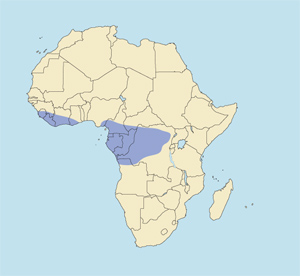 |
Cephalophus dorsalis
Duiquer bayo (Sp), Schwarzrückenducker (G), Céphalophe à bande dorsale noir, Céphalophe bai (F). Also called black-backed duiker.
DESCRIPTION Shoulder height 20-22 inches (51-56 cm). Weight 35-50 pounds (16-23 kg).
A medium-sized, heavily built duiker with a coarse coat and a somewhat porcine visage. The general color is bright chestnut red with lighter underparts, a sharply defined black dorsal band, a blackish midline on the belly, and brownish black legs. There is much individual variation in the extent of the black markings and in the intensity of the black coloration. The dorsal band usually begins at the top of the neck and ends at the tail, but in some specimens it extends from nose to tail with a break between the horns, and in others it may be indistinct or absent on neck and shoulders. In some individuals the black of the dorsal band spreads out on the lower back and rump, or may spread over the shoulders to connect with the legs. The tail is black with a pronounced white tuft. The head is brown, with a lighter stripe above the eyes. Lips and chin are white. Head tuft is absent or poorly developed. The muzzle is short and strongly tapered. Ears are brownish black on the back, whitish inside. Inguinal (groin) glands are present. Bay duikers are entirely dark at birth, the chestnut color and black markings developing after several months. The horns (both sexes) are round, slender spikes that are lightly ringed at the base and grow backward in the plane of the face. Females are larger than males, with slimmer horns, a narrower dorsal stripe, and less extensive black markings.
BEHAVIOR Solitary and nocturnal, concealing itself in a protected place during the day.
HABITAT Dense forest, preferably high, old-growth forest.
DISTRIBUTION There are two populations, separated by more than 400 miles (640 km), in the lowland equatorial forest zone. One is in West Africa from Sierra Leone eastward to Togo; the other is in Central Africa, including extreme southeastern Nigeria east of the Cross River, southern Cameroon, extreme southwestern Central African Republic, Equatorial Guinea, Gabon, Congo (B), northern Congo (K), and extreme northwestern Angola. Distribution is patchy, but the species is locally common.
TAXONOMIC NOTES Four subspecies are listed: arrheni (northeastern Congo [K]), castaneus (eastern Nigeria, southern Cameroon, and Zaire), dorsalis (Sierra Leone to Togo), and leucochilus (southward from Cameroon to the mouth of the Congo River and perhaps into Angola). They are combined here.
|





